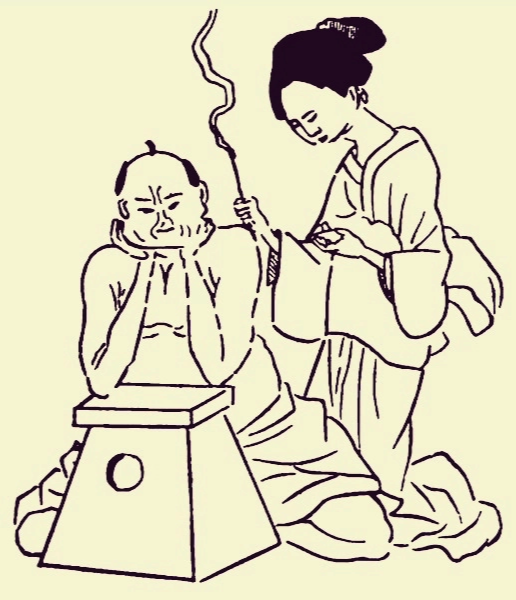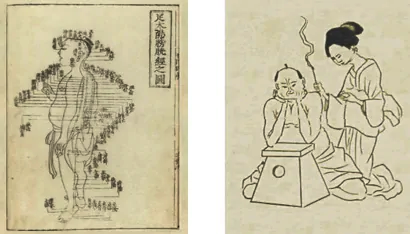A SHORT HISTORY OF CHINESE MOXIBUSTION
In a primitive society, the discovery and use of fire improved the conditions of living and raised the chances of survival and reproduction of the specie. When getting warm near a fire, some cold and pain in the joints and diseases of various parts of the body were relieved or disappeared; so it was found that the scorching, fumigating and roasting can treat diseases,It is likely to be the origin of the moxibustion technique. “Jiu” means “scorching” as well as fumigating and roasting. The character “Jiu” denotes the persistent fumigating and roasting. The earliest “Jiu” (moxibustion) refers to fumigating and roasting with bright fire with the branches of a tree or firewood as the moxibustion materials. Later, it was found that moxa floss is warm in nature and is easy to be ignited, persistent in burning and strong in penetration and has no bright fire, and cannot scorch the skin. Thus it was used as the main moxibustion materials.

The moxibustion technique was also called “attack” method and “fire” method in ancient times.
Moxibustion is the burning of mugwort over inflamed and affected areas of the body. The mugwort can come in sticks that closely resemble the circumference and length of a cigar. Moxa cones can also be burned. The mugwort, called Ai Ye in traditional Chinese medicine, is positioned over acupuncture points to stimulate the qi and blood.
Artemisia vulgaris is a species of chrysanthemum [it is in the same plant family]. The one produced in Qizhou is known as the best kind for moxa, as the climate and soil is good for its growth. The leaves of Qizhou Artemisia are thick with much more wool [soft fibers]. Moxa cones and sticks made of this kind of artemisia are thought to be the top quality used in moxibustion. In A New Edition of Materia Medica appears the following description: “The moxa leaf is bitter and acrid, producing warmth when used in small amount and strong heat when used in large amount. It is of pure yang nature, having the ability to restore the primary yang from collapse. It can open the 12 regular meridians, traveling through the three yin meridians to regulate qi and blood, expel cold and dampness, warm the uterus, stop bleeding, warm the spleen and stomach to remove stagnation, regulate menstruation, and ease the fetus....When burned, it penetrates all the meridians eliminating hundreds of diseases.” Yang can be activated by the Artemisia leaf for [because of] its warm nature. The acrid odor [spicy fragrance] of the leaf can travel through the meridians, regulate qi and blood, and expel cold from the meridians, and its bitter nature resolves dampness. As a result, it is used as a necessary material in moxibustion treatment.
Artemisia vulgaris is a species of chrysanthemum [it is in the same plant family]. The one produced in Qizhou is known as the best kind for moxa, as the climate and soil is good for its growth. The leaves of Qizhou Artemisia are thick with much more wool [soft fibers]. Moxa cones and sticks made of this kind of artemisia are thought to be the top quality used in moxibustion. In A New Edition of Materia Medica appears the following description: “The moxa leaf is bitter and acrid, producing warmth when used in small amount and strong heat when used in large amount. It is of pure yang nature, having the ability to restore the primary yang from collapse. It can open the 12 regular meridians, traveling through the three yin meridians to regulate qi and blood, expel cold and dampness, warm the uterus, stop bleeding, warm the spleen and stomach to remove stagnation, regulate menstruation, and ease the fetus....When burned, it penetrates all the meridians eliminating hundreds of diseases.” Yang can be activated by the Artemisia leaf for [because of] its warm nature. The acrid odor [spicy fragrance] of the leaf can travel through the meridians, regulate qi and blood, and expel cold from the meridians, and its bitter nature resolves dampness. As a result, it is used as a necessary material in moxibustion treatment.
Moxibustion is an important and perhaps under-utilised therapeutic method in traditional Chinese medicine. It may be used alone or in combination with other modalities, such as acupuncture....This method involves the burning of moxa on or above the skin at the location of specific acupoints, or on or near the lesion to be treated itself. The heat of the cauterization, as well as the properties of the moxa itself, serve to warm the qi and blood in the channels, expel cold and dampness, restore yang, and, in general, help to regulate the organs and restore health. Chinese Moxibustion is used:
1. To warm meridians and expel cold. Abnormal flow of qi and blood in the body usually results from cold and heat. Cold causes obstructed flow or even stagnation of qi, and heat results in rapid flow of qi. Normal heat activates blood circulation and cold impedes its smooth flow. Since stagnation of qi and blood is often relieved by warming up the qi, moxibustion is the right way to generate the smooth flow of qi with the help of the ignited moxa wool. In Chapter 75 of Miraculous Pivot it says: “If stagnation of blood in the vessels cannot be treated by warming up with moxibustion, it cannot be treated by acupuncture.” In Chapter 48 of Miraculous Pivot it states, “Depressed symptoms should be treated by moxibustion alone, because depression is due to blood stagnation caused by cold, which should be dispersed by moxibustion.”
2. To induce the smooth flow of qi and blood. Another function of moxibustion is to induce qi and blood to flow upward or downward. For example, moxibustion is given to yongquan [KI-1] to treat the disorders caused by excess in the upper part and deficiency in the lower part of the body and liver yang symptoms due to upward flowing yang qi so as to lead the qi and blood to go downward....If the disorder is due to deficiency in the upper portion and excess in the lower portion of the body and due to sinking of qi caused by deficiency, such as prolapse of the anus, prolapse of the uterus, prolonged diarrhea, etc., moxibustion to baihui [GV-20] may lead yang qi to flow upward.
3. To strengthen yang from collapse. Yang qi is the foundation of the human body. If it is in a sufficient condition, a man lives a long life; if it is lost, death occurs. Yang disorder is due to excess of yin, leading to cold, deficiency, and exhaustion of the primary qi, characterized by a fatal pulse. At this moment, moxibustion applied can reinforce yang qi and prevent collapse. In Chapter 73 of Miraculous Pivot it says, “Deficiency of both yin and yang should be treated by moxibustion.”
4. To prevent diseases and keep healthy. In Precious Prescriptions appears the following description: “Anyone who travels in the southwest part of China, such as Yunnan and Sichuan Provinces, should have moxibustion at two or three points to prevent sores or boils and to avoid pernicious malaria, epidemic diseases, and pestilence. It is often said, “If one wants to be healthy, you should often have moxibustion over the point zusanli [ST-36].” In Notes on Bian Que’s Moxibustion, it says, When a healthy man often has moxibustion to the points guangyuan [KI-4], qihai [KI-6], mingmen [GV-4], and zhongwan [KI-12], he would live a very long life, at least one hundred years.”
1. To warm meridians and expel cold. Abnormal flow of qi and blood in the body usually results from cold and heat. Cold causes obstructed flow or even stagnation of qi, and heat results in rapid flow of qi. Normal heat activates blood circulation and cold impedes its smooth flow. Since stagnation of qi and blood is often relieved by warming up the qi, moxibustion is the right way to generate the smooth flow of qi with the help of the ignited moxa wool. In Chapter 75 of Miraculous Pivot it says: “If stagnation of blood in the vessels cannot be treated by warming up with moxibustion, it cannot be treated by acupuncture.” In Chapter 48 of Miraculous Pivot it states, “Depressed symptoms should be treated by moxibustion alone, because depression is due to blood stagnation caused by cold, which should be dispersed by moxibustion.”
2. To induce the smooth flow of qi and blood. Another function of moxibustion is to induce qi and blood to flow upward or downward. For example, moxibustion is given to yongquan [KI-1] to treat the disorders caused by excess in the upper part and deficiency in the lower part of the body and liver yang symptoms due to upward flowing yang qi so as to lead the qi and blood to go downward....If the disorder is due to deficiency in the upper portion and excess in the lower portion of the body and due to sinking of qi caused by deficiency, such as prolapse of the anus, prolapse of the uterus, prolonged diarrhea, etc., moxibustion to baihui [GV-20] may lead yang qi to flow upward.
3. To strengthen yang from collapse. Yang qi is the foundation of the human body. If it is in a sufficient condition, a man lives a long life; if it is lost, death occurs. Yang disorder is due to excess of yin, leading to cold, deficiency, and exhaustion of the primary qi, characterized by a fatal pulse. At this moment, moxibustion applied can reinforce yang qi and prevent collapse. In Chapter 73 of Miraculous Pivot it says, “Deficiency of both yin and yang should be treated by moxibustion.”
4. To prevent diseases and keep healthy. In Precious Prescriptions appears the following description: “Anyone who travels in the southwest part of China, such as Yunnan and Sichuan Provinces, should have moxibustion at two or three points to prevent sores or boils and to avoid pernicious malaria, epidemic diseases, and pestilence. It is often said, “If one wants to be healthy, you should often have moxibustion over the point zusanli [ST-36].” In Notes on Bian Que’s Moxibustion, it says, When a healthy man often has moxibustion to the points guangyuan [KI-4], qihai [KI-6], mingmen [GV-4], and zhongwan [KI-12], he would live a very long life, at least one hundred years.”

The relationship of moxibustion to the herbal material used for moxa wool depends on the technique. For example, when moxa cones are burned on the end of acupuncture needles, the constituents of the moxa do not interact with the skin and the local effect is that of transferring heat to the acupoint. When a moxa pole is used, there is some transfer of active constituents to the skin, but not much; the effect is still mostly heat, but to a broader area. When the moxa cone is burned directly on the skin, active constituents are transferred to the skin. This latter method was the most commonly used traditional approach, as best as one can tell from the old literature.
When moxa is burned on top of another herbal material, such as a slice of ginger or garlic, cake of aconite, or mound of salt or powder of herbs in the navel, the heat will drive some of the ingredients of the interposing herbal material into the skin, but little of the moxa wool ingredients will penetrate. Fresh ginger, one of the commonly used interposing materials, contains compounds similar to borneol and camphor (small holes in the slice of ginger or slice of garlic permit a little of the moxa vapors to penetrate).
When moxa is burned on top of another herbal material, such as a slice of ginger or garlic, cake of aconite, or mound of salt or powder of herbs in the navel, the heat will drive some of the ingredients of the interposing herbal material into the skin, but little of the moxa wool ingredients will penetrate. Fresh ginger, one of the commonly used interposing materials, contains compounds similar to borneol and camphor (small holes in the slice of ginger or slice of garlic permit a little of the moxa vapors to penetrate).
An additional impact of moxibustion may be to help sterilize the atmosphere of the rooms in which it is being used. In China an incense made of artemisia and atractylodes (cangzhu), when burned in an outpatient operation room, would reduce the bacterial count in the air. It also apparently inhibited viruses. According to Chinese evaluations, it could be used in kindergartens and nurseries to reduce the transmission of diseases, including chicken pox, mumps, scarlet fever, common cold, and bronchitis. Thus, when used in an acupuncture clinic, the smoke from moxibustion might help to prevent transmission of disease from one patient to another, which is especially important when dealing with immune-compromised patients.

